Temecula Valley Rose SocietyAn Affiliate of the American Rose Society |
||
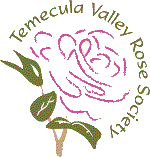 |

|
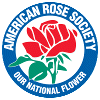
|
Temecula Valley Rose SocietyAn Affiliate of the American Rose Society |
||
 |

|

|
Jump to this month's program.
Jump to Frank Brines' FUNdamentals
Jump to Calendar of Events
All product names, logos, and brands are the property of their respective owners. All company, product and service names used in this newsletter are for identification purposes only. Use of these names, logos, and brands does not imply endorsement.
by Virginia Boos

In 2020, I'm hoping to surround myself with volunteers and Board members who can help me continue with the success we've had in 2019. So many new members joined that it was close to overwhelming. Many of these new members have generously volunteered their time and skills and I look forward to working with them so that we will achieve our goals. We are getting prepared for a most Happy New Year.
by John Weersing, Newsletter Editor
and Information Technology Manager

Since the Internet came into popular existence 25 years ago (roughly 1995) its content has changed tremendously. We now shop online, view Google Earth images from around the world, watch movies, play music, play games, and so on. The migration from desktop PCs to tablets (laptops) to mobile / cell / smart phones has required many technical changes in how web pages (the Internet's content) are displayed. The TVRS website has been no less affected.
The computer or mobile phone program you use to view Internet content is called a browser. There are more than a dozen different browsers, the most popular being Google's Chrome. As Internet content changes (e.g. videos and live chat) an updated browser is also needed. To view the TVRS website and newsletter as designed you should have a current browser installed on your computer or phone. They are available FREE from the originating company: Microsoft, Chrome, or Apple. After downloading a most current browser of your preference turn on automatic updating and you'll be assured of being able to view the latest Internet content as the designers intended. To obtain the Chrome browser enter this in the Google Search box: "download chrome for windows [or Apple]". Read the choices and follow the instructions. If you don't know how to do this ask any grandchild!
To allow for the (pleasant) viewing of the web pages on a 4.25-inch high mobile phone screen every page had to have certain technical changes made. This took 2-1/2 months in summer 2019. The text content could, and was, left unchanged for the most part. The images were another matter. They were originally sized for a 10-inch PC screen, and to display the same image on a 4.25-inch high screen posed some technical challenges. This was done successfully for the most part without resizing the photos. (There are nearly 1,400 images on the website!) However, from time-to-time, a page may appear weird, the images overlapping text and sometimes each other. The problem occurs with 4.25-inch screens. The immediate solution is to view the page on a tablet (laptop) or PC screen. Reasonable attempts will be made to display them properly but there is a limit on what can be done without further HTML and CSS coding, time I don't have.
The website layout is twelve years old: It just grew like Topsy, and it shows. Links to its pages were added, not at random, but without an overall scheme. This year (2020) a thorough review will be made to make the site easier to navigate. Some changes have been made already: the floating menu on every page was removed, there simply was not enough room on a mobile phone screen to show it on every page. Except for the Home Page (index.shtml), the menu now appears as a separate page.
Google Analytics tracks every page hit to our website, and the Rose Haven Garden page is the most popular with 52% of the hits for the last three months of 2019. Sixty-five percent of the accesses were from mobile phone devices. The website gets hits from around the world: China, New Zealand, Israel, India, Hong Kong. Our site can be accessed from anywhere in the world in just a few seconds. While on a tour of Mongolia several years ago I accessed our site from the hotel cyber café in Ulan Baator.
Some content has already been reorganized. All articles about the Vogel's Iris Garden now appear in a single page for easy reference. An ARS series of 19 articles has been "rescued" from the newsletter archive and made accessible through the Rose Care Tips page. Our many rose show, first bloom and last bloom photos and text are now accessible through a single link on the Menu (Our Rose Show Photos). More changes will be made following the 2020 review.
To liven-up the website informational pop-ups were added. Also, on the Rose Haven page hover your mouse pointer over the satellite photos of the garden to see them grow in size. However, this special effect looks bad on a mobile phone and may be removed.
Starting twelve years ago the TVRS newsletter was uploaded monthly to the Internet to increase access and reduce printing and mailing costs. Although Bonnie Bell still prints a hard-copy newsletter, it's only for a few members. To ease the transition the online newsletter format was made identical to the former printed version. The President's column was at top left, the month's program top right, and the FUNdametals article across the bottom. Going online also made it possible to include color photos at no extra cost, which was financially impossible with the printed version.
This format – two columns wide – was easily accomplished and looked great on the wide-screen PCs of the day. Reproducing this format on a 4.25-inch high cell phone screen in landscape orientation caused viewing problems. Images sometimes overlapped text and text paragraphs would appear in different sizes, making a page's appearance inconsistent. Images would sometimes shrink to near invisibility. It took a great deal of work but most of these glitches have been fixed. However, problems still occur. If you view a page that looks bizarre email me the page name and I will try to fix it. My email address is here.
For technical reasons the 'This Month's Program' block may not appear at top right; sometimes it may appear at bottom left. The amount of time spent in trying to fix this was inordinate, so it remains a "floater."
The online newsletter has always contained much color clipart and graphics. In the last few years much internet content is now copyrighted. Many of these little "visual candy" images had to be removed. Images can still be used but copyright notices must be included. If you submit photos for the newsletter that you didn't take yourself, you must say where the image came from: e.g. Photos by 'source-name' or © date - owner(s). Under the "fair use" doctrine we can still use copyrighted material without payment but with proper accreditation and discretion.
The website contains all twelve years of newsletters since going online, over 100 issues. The 2019 issues were changed to accommodate mobile phone screens, but so few of the previous year's issues are accessed that they weren't, and won't, be upgraded. You can view them, but the format may appear weird. If you want to read issues before 2019 it is best done on a laptop or large-screen desktop.
To identify the source of material, articles written outside TVRS (e.g. Carl Love Press-Enterprise stories) appear with a white background. Our content appears on a pink background.
To liven-up the newsletter informational pop-outs will be added on occasion. To view the effect, hover your mouse pointer over the green link in the December article on AmeriCorps and 501(c)(3) non-profits.
by Linda Freeman
Growing tips from our member garden tour hosts:
Don Nordike – prunes his roses on Superbowl weekend. When roses start budding out he presoaks the soil and feeds with rabbit pellets (alfalfa) and Epsom salts (1 cup for established older roses and 1/2 cup for newer roses). Resoak the soil after feeding so the Salts soak in. One week later, water heavily again and use any 15-15-15 rose food, and then water again after feeding. Mulch roses with 2-3 inches of mulch (Don's preferred is Kellogg's mulch). If another application of fertilizer is desired use fish emulsion (follow directions on label) – nothing more after June, and if weather cools in September you can prune 50% of your rose bush and you may get a new flush of roses in November.
May Olson – Her best rose companions: Lavender, yarrow, and garlic, great for killing thrips in the soil: Coffee grounds, banana peels, egg shells, veggie peelings, orange peels and 'Gardner and Bloome Soil Conditioner' break up the clay. Buy it at Nutrien L&M in Temecula and get 10% off for members. Fish Emulsion the best fertilizer, especially for potted roses. Epsom salt: 1/2 cup around rose perimeters once a year. May loves Magnum brand for feeding Roses that bloom the most: Barone de Rothschild, Rio Samba, Brandy, Perfect Moment and Wild Blue Yonder. Biggest bloomer: First Prize and other favorites, George Burns and Elizabeth Taylor. If you have clay soil dig hole, apply a soil conditioner, water the hole, allow hole to drain and then plant the bush.
Jim Moss – He applies Epsom Salts once or twice a year at 1/2 cup per plant. His first feeding is in the spring with a high nitrogen fertilizer, such as 16-6-8, then feed regularly with 6-6-6, and ALWAYS waters-in all Salt applications. Also, use fish emulsion every other feeding. Used coffee grounds make your garden worms happy. Kellogg's brand mulch is preferred with a 1- to 2-inch application; the darker the mulch the better. Tree bark mulch is not recommended.
Virginia Boos – She applies small amounts of mulching around each bush, but away from the crowns. This keeps the soil moist longer. Apply after pruning and weeding. Epsom salts were used in the early days. Epsom Salt is magnesium sulfate, a mild fertilizer, and is supposed to help basal breaks (new canes). Virginia's rose bushes were getting dry crowns as they aged, so she stopped using the Salts a few years ago. It can be applied about 1/2 cup per bush after pruning, but before the new growth starts.
Date: Thursday, January 16
Time: 10:00 a.m. to 1:00 p.m. See our meeting schedule here.
Place: Ronald H. Roberts Public Library, Community Room B, 30600 Pauba Rd., Temecula
Topic: The Easiest Way to Cultivate More Energy and a Longer, Rosier, Healthier Life
Speaker: Jan Tucker
Jan Tucker is a certified level 5 Qigong healer and trainer, a level 2 Reiki practitioner, and author. She studies Qigong with International Qigong Grandmaster Chunyi Lin, founder of Spring Forest Qigong. Jan pursued Qigong to strengthen her immune system and prevent recurring bouts of bronchitis, asthma, allergies, eczema, digestive issues, and depression. Recognizing the power and holistic health benefits of Qigong, she now offers these benefits to others through Qigong Movement & Meditation Classes and individual Qigong healing sessions.
A qigong healer is able to transmit qi/chi, which actually allows them to help heal their clients. By helping to rebalance the body and remove energy blockages, the healer can improve both your physical and mental state. Reiki is a form of alternative medicine called energy healing. Reiki practitioners use a technique called palm healing, or hands-on, healing through which a "universal energy" is said to be transferred through the palms of the practitioner to the patient in order to encourage emotional or physical healing.
A light buffet luncheon will be served around 11:30. Guests are welcome.
| Birthdays | New Members |
|---|---|
|
Steve Boos 1/29, Jayne Chapman 1/2, Alicia Cline 1/13, Mary DeGange 1/?, Peter Gagliardi 1/11, Becky Michalkiewicz 1/28, Lenore Vogel 1/6. |
♦ Sarah Thalasinos and Beverly Brown |
by Bonnie Bell

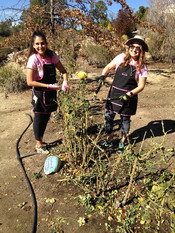
Happy New Year everyone. Winter has arrived, Southern California style, and the garden still looks quite attractive, especially the succulents. There have been many visitors between the rainy days, and January weather hopefully will be mild so all can continue to enjoy the garden.
At Rose Haven we start the year in high gear as once again it's rose time. Wednesday and Saturday mornings are the scheduled workdays beginning January 4th at from 9:00 to 11:00 a.m. and we hope many of you will join in. We begin with the roses along the driveway, and then roses in the Picnic area where the huge pepper tree is, but you can choose your own area if you prefer.
Our pruning class for members and the public will be Saturday, January 25th at 10:00 a.m. There will be several stations starting with novice to advanced rose care including hands-on demonstrations. This event is an enjoyable way to learn and share our love of roses with fellow members and the community.
See the Rose Haven Garden web page here. Click here to see the Google map to Rose Haven Garden.
by Rebecca Weersing

Memories of favorite roses can be reawakened in most unexpected ways. This holiday season my memories were triggered by the 'Nutcracker Ballet', a gift of a rose scented candle, and a magazine article written by ARS President Bob Martin, printed in the 2019 American Rose Annual.
During December it is a family tradition to attend a performance of 'The Nutcracker' in which my daughter's childhood friend dances to our hearts content as our favorite ballerina. On Christmas Day I received a rose scented candle appropriately named 'Ballerina Rose' – and, yes! the fragrance was the same as if I was standing over the 'Ballerina' Rose that graced my garden for many years. Then serendipity occurred when I opened the 2019 American Rose Annual and a beautiful photo of 'Ballerina' greeted me on page 40. How I love this rose!
The article written by Bob Martin is titled "The Useful Hybrid Musk". If you are not familiar with Hybrid Musk roses this might be the year to learn more about them. A rose many of us enjoy both in our own gardens and at Rose Haven is 'Sally Holmes'. Thanks to Bob, I will cherish it all the more as he shared in his article that 'Sally Holmes' is a cross between Hybrid Tea 'Ivory Fashion' and Hybrid Musk 'Ballerina'. Editor: Hybrid Musk Roses. A valuable class of border shrubs, bearing their flowers in large trusses like a Floribunda, but generally of a much more refined quality, having long, graceful growth and delicate ... colors. They flower profusely in early summer and intermittently later. Many have a delicious musky fragrance. Read more here from Jackson&Perkins®.
by Rebecca Weersing
Saturday, January 25: Pruning! Pruning! Pruning! We will invite the community for our annual demonstration and hands – on pruning event at Rose Haven. Membership will have a registration table as people arrive. There will be a "Caring for Tools" station. The next station will be a demonstration by Ray and Bonnie on gross pruning (reducing an out of control bush to a manageable size). Virginia and her team will show the finer details of pruning – eliminating dead wood, opening the center of the bush for better airflow, removing any thin weak growth, prune remaining canes to an outward facing bud. Clean-up is the last but a very important step. The waste material is placed in the disposal bin and not in a compost bin. This prevents diseases being unknowingly passed on to other bushes. Master Consulting Rosarian Frank Brines will answer advanced rose care questions at our final Rose Station. Please join us in helping our community learn to prune at Rose Haven. We need many willing hands to create a lovely blooming garden in the spring.
by Rebecca Weersing
At least ten years ago the Temecula Valley Rose Society donated roses to Red Hawk Elementary and to Susan LaVorgna Elementary. We have been requested to assist with the pruning of these roses. If you are willing to help with the pruning, please email me here: temroses@gmail.com. We have not decided on a date or time, but I will let you know when and where if you are interested.
by Rebecca Weersing
The Rose Haven Committee will meet on Wednesday, January 22, 2020 at 10 a.m. in the Pavilion at Rose Haven. We are a year from celebrating our '30th Anniversary of Growing', as the garden was established in 1991. Our goal is to spruce up the entire garden as well as in-depth attention to specific areas of the garden.
The 'Rose Hall of Fame' and the 'Boos Entry Courtyard' will be receiving renovations and a redesign. The 'Rose Hall of Fame' consists of the world's favorite roses. Seventeen roses have been inducted into the 'Rose Hall of Fame' since 1976 (one every three years). Our goal is to have three each of the 17 roses in our 'Rose Hall of Fame Garden'. We currently have more than three of some roses, none of some. We need to purchase a total of 21 roses to complete our vision. Should anyone like to contribute to 'The Rose Hall of Fame Renovation Project' a donation of $30.00 will help us acquire one rose. Send your donation to our mailing address or give to Bonnie at our member meeting on January 16th. At planting time we will have a Planting Party – please join us!
by Virginia Boos
Have you noticed the green badge worn by some of our members? You may have wondered just what it is and why these individuals are wearing it. The Support Team is a group of volunteers doing just that – supporting our rose society in a variety of ways. They are the hosts and hostesses of our gatherings.
This idea was launched a year ago with a ribbon-cutting ceremony at our December 2018 meeting. The plan is to create a team of "helpers", doing whatever can be done to further our goal of a cohesive community. They can greet people at the door, lead tour groups at Rose Haven Heritage Garden, as well as offering information and guidance to visitors. In other words, just be friendly and courteous, helping to maintain a welcoming atmosphere. An informational tour guide booklet is being prepared, complete with a garden map with descriptions and the history of various areas there.
Would you like to be a part of this effort? I have several extra badges just waiting to be claimed.
Please join our Garden Club Friends for their upcoming meeting on January 14, 2020 at 9:30 a.m. at the Temecula Community Recreation Center, 30875 Rancho Vista Road, Temecula. The Program: Olive Cultivation and EVOO Nutrition, with speaker Jenna Fenton.
Jenna Fenton is a third-year student at Cal Poly, Pomona and recent recipient of the Temecula Valley Garden Club Scholarship. Jenna has been helping in her family's olive oil business, The Olive Plantation, since the age of 10 when she helped her father plant 1,000 olive trees on the family property. She will share experiences and expertise along with the nutritional benefits of extra virgin olive oil. She will bring items from the Olive Plantation for purchase.
by Frank Brines, Master Consulting Rosarian

Happy New Year! This month I'm going to help you get ready for the major late-winter pruning you should do in mid- to late-February. (I'll provide details on pruning in my February column.) You are welcome to join me for an in-person rose care workshop at Rose Haven Heritage Garden (30592 Jedediah Smith Road in Temecula, just a few blocks north off of Temecula Parkway) on January 25, 2020 at 10:00 AM to noon. Bring your questions!
In our area – the corridor from Riverside to San Diego – this major annual pruning should be done around mid-February. It resets the plants' biological clock, acting as a wake-up call to begin a new life cycle. You can expect the first flush of blooms about 10 weeks after pruning.
As much as you'd like to have blooms as soon as possible, don't jump the gun on this! Some gardeners think pruning in December or early January will give them a head start on flower production, but that's a delusion. First, even if January brings exceptionally warm air temperatures, the soil will still be quite cold, so the roots (and stems) will not be "revved up" for much active growth – your head start won't amount to much. More importantly, if early pruning is followed by a hard frost you'll probably lose the tender young growth and have to prune again. Will the remaining canes be long enough and have enough stored energy for vigorous spring growth? Will you have enough outward-facing buds? Probably not. Simply stated, pruning too early will set back stem growth and flower production, and can ruin your chances of strong, well-formed plants.
I think you'll be able to hold off after experiencing the recent storms that brought plenty of cold rain and freezing (or near freezing) night-time temperatures to the Temecula Valley! Next week's weather forecast for the Temecula Valley (and other inland valleys) is for some rain in most areas and lows in the 30s. In the Temecula Valley, the last average frost date is March 31, so you're probably safe pruning in mid- to late-February. Of course, it's always a gamble. The best advice is to watch the weather.
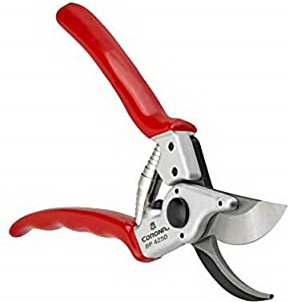
But this month get your tools ready! You need a good pair of "bypass" hand pruners (like those made by Corona® Tools) that fit comfortably in your hand. "Bypass" pruners have a sharp curved cutting blade (which slices through the cane) and a dull curved non-cutting blade (which holds the cane in place during the cut). The sharp blade "bypasses" or slides over the dull curved blade. This is in contrast to pruners that have a sharp flat blade that comes to rest against a flat dull blade; toss those pruners out!
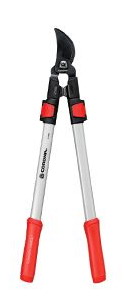
At minimum, also have at least one pair of sturdy loppers handy. Each size has a maximum diameter it can cut efficiently. Using pruners or loppers that are too small on a too-large cane can damage both the tool and the cane. A hand saw with a narrow blade can also be handy if you have some older plants with large canes that may need to be removed.
All tools should be kept clean. Rubbing alcohol and cotton balls are ideal for cleaning cutting blades, before and during the job. This helps prevent disease transmission from plant to plant and you can use it as first aid on your own cuts, scratches, and punctures! (On that note, a good pair of leather gloves are necessary with long sleeves or separate pair of sleeves to protect our arms.)
Before starting the job, apply a little light oil (such as 3-in-1 oil) to each tool's moving parts and make sure they operate without resistance. Sharpen each blade with a small diamond file (available at garden centers), trying as much as possible to match the original bevel of the blade. When you're actually pruning, swipe the file over the blade a few times every 100 cuts or so to keep it sharp. If you notice that your pruners are crushing the stems and/or leaving a tail, it's past time to sharpen them! To minimize damage to the cane keep this rule in mind: The sharp blade should always face the part of the plant that will be left. This will minimize the crushing of the cane or stem as it will be the part that is discarded. This rule also works for preparing stems for arranging or putting into a vase.
January and February are excellent months for planting new roses in the Temecula Valley and environs. Still, one can usually wait until March to plant and still expect the roots to form relationships with beneficial soil fungi and become showstoppers as early as May, well ahead of the summer heat. Potted rose bushes will be optimal for these late plantings.
For now, be thinking about adding one or two new roses to your garden in spring. Roses offered for sale are rated by quality. You want only #1 roses – they are the surest guarantee of success, with all horticultural methods employed to provide satisfaction – don't waste your time and money on anything lower. Higher quality plants have a higher chance of success, require less effort, and acclimate faster. Also, the cost of any rose is a very small fraction of what you will eventually invest in that plant over the years in water, fertilizer, pest control, and effort, so why not start with a first-quality plant?
Roses may come to you as "bare root", potted, or packaged. Bare root plants are just that, usually packed in wood chips to keep the roots damp and viable. They are slower to thrive and it is best to get them early and planted immediately so they have the maximum amount of time to become established. (When you acquire a bare root rose, be sure to soak its roots in water for 24 hours, then plant promptly.) packaged roses are the slowest to thrive as they have been drastically root pruned to fit into the plastic sleeves. Potted roses make the quickest and most successful transition to the garden, but they also tend to be more expensive and not as plentiful in selection, but as I said, the initial cost will pale against what you put into the plant in the years to come.
Rose plants are beginning to be stocked at nurseries and retailers now. You might find some good values. There are many sources: local nurseries and reputable online retailers who specialize in roses. New stock will begin appearing in nurseries this month, and online suppliers usually ship in mid-January. (Does that tell you anything?) But be sure to shop early for the best selection – and if you have access to it, be sure to consult your American Rose Society Buyer's Guide (which you will receive with your annual ARS membership or renewal). I received my ARS 2020 Rose Annual edition a month or two ago, and in my opinion it is one of the best (if not the best) issues published so far. It is full of rose info and tips and new varieties one might desire to secure.
As I said earlier, I will provide guidance on that all-important annual pruning in the February column. Also, check local newspapers and nursery websites for schedules of hands-on pruning classes at different locations, and the TVRS Rose Society will have hands-on pruning demonstrations January 25 at Rose Haven Heritage Garden, located at 30592 Jedediah Smith Road in Temecula (just a few blocks north off of Temecula Parkway). Please bring clean, sharp, by-pass pruners in good working condition, and be prepared to learn and to lend a hand pruning under experienced direction. This will be a great opportunity to get your questions answered, hone your skills, and boost your confidence.
For more ideas, visit TVRS' Rose Haven Heritage Garden. Click here to see the map to Rose Haven Garden in Temecula, as well as our Society web site at Temecula Valley Rose Society.org. Spread the joy of roses!